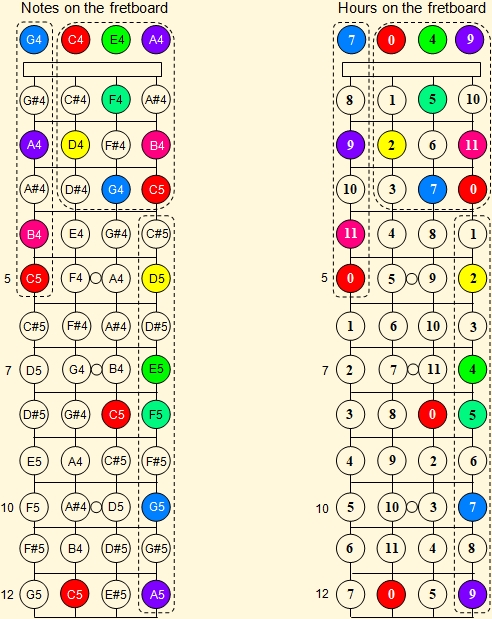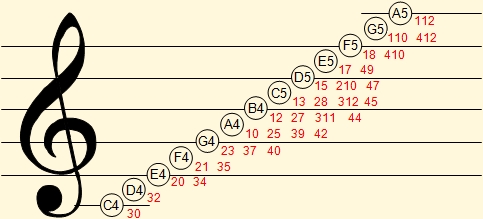
Notes on the ukulele fretboard
In the Musical Notes section of the Theory page we saw that Western music, which we will deal with exclusively in these pages, uses the twelve notes of the chromatic scale; therefore, in order to achieve dexterity in the execution of known melodies or the creation of new melodies in the ukulele you need a complete familiarization with the location of these notes on its fingerboard. This is something that will take some time, but since in theory we use the major C scale to illustrate the creation of scales and chords, let's begin by identifying a first location of this scale on the ukulele fingerboard. This is something that will take some time, but that will be facilitated and strengthened through practice.
Below is the location of the notes, and their corresponding hours in the clock analogy, on the fourteen frets of a standard ukulele:

As we will see in the section that follows the following observations and deals with the determination of notes and frets on the fretboard, for some tasks it is simpler to use this second alternative.
Note that:
- As explained on the Musical Notes page, notes separated by an octave belong to the same class and are given the same name; therefore, the notes on fret 12 are the same as those on open strings but an octave higher. For an instrument with more than twelve frets, the notes on frets 13, 14, 15,... will be the same as for frets 1, 2, 3,..., respectively.
- Due to the re-entering tuning of the ukulele, in which the fourth is higher than the third and the second,the first three strings contain all the notes available in this instrument; therefore in these pages the fingerings of scales will be shown on these first three strings. In the previous figure, the rectangle above and to the right contains the major scale of Do over the interval from C4 to C5.
- The fingering of some three-note chords will be simplified if the fourth string is used; in addition,four-note chords can only be played using this string. In the diagram the location of notes G4, A4, B4 and C5of the previous scale on the fourth string has been added.
- The only possible fingering of notes F5 to A5 is on the first string, so an elongated vertical rectangle has been added covering notes C#5 to A5 on the first string.
- The notes in the two blocks on the right allow you to interpret any melodywithin the note register of a ukulele with twelve frets, notes C4 to A5.
- It is convenient to memorize the different locations of note C on the fretboard of the ukulele,therefore these are shown in the previous figure. For this memorization your knowledge of the way in which this instrument is tuned will help you.
Notes of the ukulele on the staff
Since the most complete notation used for the transcription of melodies is the standard (classical) notation, it is convenient to know the arrangement of the notes of the ukulele on the staff:

The Arabic numerals that are located a little below and to the right of the notes correspond to the nomenclature that we will use in these pages to indicate the fingering of the notes: the first digit identifies the string on which the note is fingered and the next digit(s) corresponds to the fret. For example: the fingerings indicated for note C5 are 13, 28, 312, 45, which can be verified in the diagram of the fretboard of the previous figure.
Various